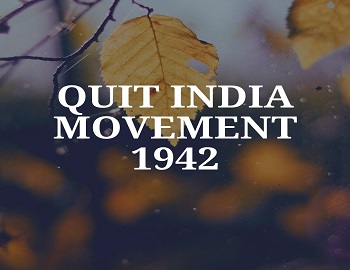Table of Contents
Quit India Movement 1942:
| The “Quit India” or “Bharat Choro” was the simple slogan that launched the legendary struggle and is also known by the name of “August Revolution”. The people of India displayed unparallel heroism and militancy unparallel because the repression of the British government was more brutal than ever used by any country against a national movement. Justifying itself in the name of “war effort” the government armed itself with Draconian measures and suppressed the basic civil liberties. Every political activity was made illegal and revolutionary activity treason. |
Reasons for the Launch of the Quit India Movement:
| (1) Failure of Cripps Mission- The offers made by the Cripps Mission and its subsequent failure made it clear to the leaders that the British government was not willing to offer any concrete settlement. She was rather more interested in forcing India to support its war efforts. Even Gandhi and Nehru, who were against the Fascist and Nazi governments, began to feel that being a silent spectator would simply mean accepting the fact that the decision regarding the political fate of India was only in the hands of the British. Gandhi, who was against the idea of hampering the war efforts of the British against Germany and Italy, also began to feel the necessity of a non-violent struggle. (2) Japanese posed a threat to India- During World War, Japan was on the side of the Axis Powers. On December 7, 1941, Japan attacked Pearl Harbour, an American naval base in Hawaii Island, which caused anxiety to Britian, the USA and China. Then Japan overran the Philippines and Malaya. In February 1942 the Japanese seized Singapore. After occupying Myanmar (Burma), they marched towards Assam. Gandhiji observed, “The presence of British in India is an invitation to Japan to invade India. Their withdrawal removes the bait”. Some Congressmen did not agree with Gandhiji about starting a mass agitation during the course of the war. However, they agreed to abide by his decision; and those who did not agree (like C. Rajagopalachari) quit the Congress. The threat of a Japanese attack on India because of the presence of the British was one of the important reasons for launching the Quit India Movement. (3) Popular Discontent- Prices of foodgrains were rising up almost 60-point rise in eastern U.P. between April and August 1942. There was also a shortage of rice and salt. During the crisis of food grains, the Indian market was left in the hands of black marketers, and profiteers which affected the poor most, especially in eastern India. The Congress leaders felt that the time has arrived to give direction to the general discontent among the masses. (4) Racial Character of the British Empire- The manner in which the British evacuated Malaya and Burma exposed the real character of the British Empire. The British, in these colonies, evacuated the white residents and left the local population to their own fate. It exposed the racial character of the British. (5) Other Causes- (I) There was anger and hostility towards meaningless war especially when thousands of wounded soldiers returned from the Burmese war. (II) The arrogance of the British, Americans and Australians, the maltreatment of Indian people, particularly incidents of rape, made the grievances even more forceful. (III) Japanese success story in South-East Asian countries demystified the superiority of Europeans especially English. |
Quit India Resolution:
| The Congress Working Committee met at Wardha in July 1942 and demanded the immediate withdrawal of the British from India. It adopted a resolution known as the Quit India Resolution. The All- India Congress Committee passed the resolution at its meeting in Bombay on August 8, 1942. On the same day, Gandhi gave his call of ‘do or die’. The Resolution said that- (I) British rule in India must end immediately. The British were told in clear ever term- ‘Quit India’. (II) India is committed to defending itself against all types of Fascism and Imperialism. (III) A provisional government of India after British withdrawal. |
Programme of the Quit India Movement:
| Though the programmes for the Quit India Movement were never issued, Gandhi did give instructions to every section of the society in his famous speech at Gowalia Tank Ground (Bombay)- (I) To the Government Servants- Do not resign but openly declare their allegiance to the Congress. (II) To the Soldiers- Do not leave the army but refuse to open fire on the Indians. (III) To the Students- Leave studies if they were confident that they would remain firm till independence was achieved. (IV) To the Peasants- If zamindars are pro-government, don’t pay the rent. If they are anti-government, pay. (V) To the Princes- Support the masses and accept the sovereignty of people. |
Course of the Quit India Movement:
| On 8th and 9th August 1942, the government arrested all the prominent leaders of the Congress. For once, this pre-planned action of the government left the Indian people without leadership. Mahatma Gandhi was kept in prison at Poona. Pandit Jawaharlal Nehru, Abul KalamAzad, and other leaders were imprisoned in the Ahmednagar Fort. At this time, leadership was provided by Ram Manohar Lohia, Achyuta and S.M. Joshi. The role of Jayaprakash Narain in this movement was important. He formed Azad Dasta in the jungles of Nepal and trained the guerillas in storming the Jails. Usha Sharma started an underground radio in Bombay. The revolutionaries also succeeded in setting up parallel government at many places like Tamluk in Midnapur (Bengal), Talchar (Orissa), Champaran (Bihar), Satara (Maharashtra) and Ballia (U.P.). A large number of students also left their schools and colleges to join the Quit India Movement. The youth of the nation also participated in this movement with patriotism. Strikes, demonstrations and public meetings were organised in various towns and cities. Slowly the movement reached the rural areas. In 1943, as the Quit India Movement gained further momentum, there were armed attacks on government buildings in Madras and Bengal. In 1944 MahatmaGandhi was released from jail. |
Features of the Quit India Movement:
| (I) Quit India Movement was a spontaneous movement. (II) It was not non-violent like earlier movements of Gandhi, it was the first violent movement and the last one too launched by Gandhi. There were many incidences of violence. (III) It did not attract the labour class in general. (IV) Gandhi did not call for the government servants to leave their jobs but declare their support to Congress. Similarly, he asked the army not to leave, but not fire on compatriots. |
Reason for the Failure of the Quit India Movement:
| The failure of the Quit India Movement was due to many causes. The first was the tactical mistakes of organization and planning. The arrest of Mahatma Gandhi and the Congress leaders left the people without any leadership or guidance. There was no coordination and no strategy. Those who led the movement were divided in their views on the course of action. Nobody knew what to do. The loyalty of the services and the superior physical strength of the Government succeeded in crushing the revolt. The movement did not have the support of the upper classes of India consisting of rich merchants, landlords and princes and also a part of labour. On the whole, the Muslims remained aloof from the movement. They were told by the Muslim League that the movement was directed to coerce the British Government to hand over to the Hindus the administration of the country. |
Significance/Impact of the Quit India Movement:
| Despite being a short-lived movement, the Quit India Movement had a tremendous impact on the people of India- (I) It had the widest social base. Princely states participated. Peasants from lowest to highest strata participated. Even zamindars supported or remained neutral. Raja of Darbanga one of the biggest zamindars asked his men to help the peasants who had been arrested. (II) People acquired Great Capacity for Struggle and Sacrifice- The British viewed the situation as a challenge and used force to suppress the Movement. Mobs were dispersed with lathi-charge, rifles, pistols and machine guns. Yet the people were not disheartened. The show of such extreme courage and sacrifice of the Indians made the foreign imperialists conclude that they must be prepared to quit India in the near future. Lord Linlithgow, the Viceroy and Governor-General (1934-43) confided to the British Prime Minister that it was “the most serious rebellion since that of 1857, the gravity and extent of which we have so far concealed from the world for reasons of military security”. (III) It made the British realize that their Days were Numbered- The Quit India Movement, though short-lived, gave the signals that the British rule was not wanted in India. There was nothing to stop Indians from attaining their freedom. The signs of the firm determination of the people to free India from the British hastened the British decision to quit. Thus the Quit India Movement marked the culmination of the Indian Freedom movement which had begun in 1857. The violent mass upsurge of 1942 left no doubt that the freedom battle in India had reached its flashpoint and the day had dawned for the British to quit. |









Comments (No)